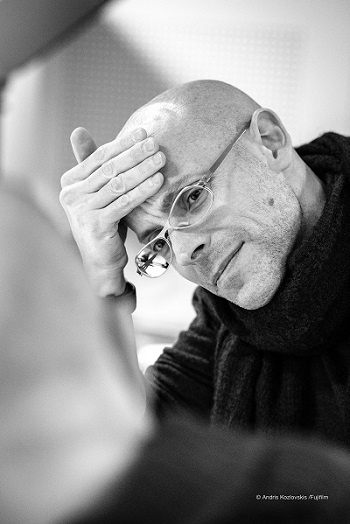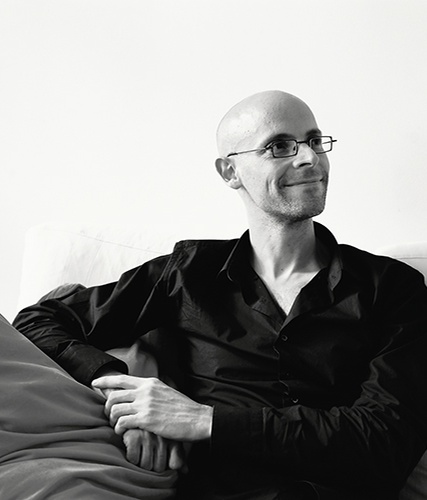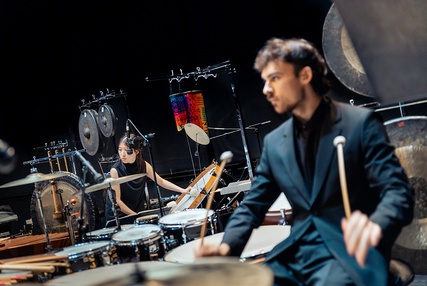Mauro Lanza en studio
La préhistoire du futur | Enjeux artistiques
 Nous sommes dans un futur fort fort lointain, dans des milliers, voire des millions d’années… Voilà bien longtemps que le genre humain s’est éclipsé de cette vallée de larmes. Les traces de son existence passée, en revanche, sont partout disséminées dans la poussière de notre planète. Quelque archéologue du futur – est-ce une équipe d’explorateurs extraterrestre ? Une intelligence artificielle envoyée d’un monde lointain ? Ou même une machine d’origine bel et bien humaine qui soudain se réveille d’un très long sommeil ? – découvre, parmi les ruines et vestiges de nos civilisations successives, divers appareils et objets qui l’intriguent. Au fil de ses recherches, notre Indiana Jones cosmique comprend que les objets sont porteurs d’informations, et que les appareils servent à les lire. Mais quelles sont ces informations et à quoi servent-elles ? Pourquoi se trouvent-elles en telle abondance, certaines reproduites des millions de fois à l’identique ?
Nous sommes dans un futur fort fort lointain, dans des milliers, voire des millions d’années… Voilà bien longtemps que le genre humain s’est éclipsé de cette vallée de larmes. Les traces de son existence passée, en revanche, sont partout disséminées dans la poussière de notre planète. Quelque archéologue du futur – est-ce une équipe d’explorateurs extraterrestre ? Une intelligence artificielle envoyée d’un monde lointain ? Ou même une machine d’origine bel et bien humaine qui soudain se réveille d’un très long sommeil ? – découvre, parmi les ruines et vestiges de nos civilisations successives, divers appareils et objets qui l’intriguent. Au fil de ses recherches, notre Indiana Jones cosmique comprend que les objets sont porteurs d’informations, et que les appareils servent à les lire. Mais quelles sont ces informations et à quoi servent-elles ? Pourquoi se trouvent-elles en telle abondance, certaines reproduites des millions de fois à l’identique ?
Cette conscience si lointaine de la nôtre saura-t-elle formuler l’hypothèse qu’il s’agit là de codes pour restituer une onde sonore ? Comprend-elle d’ailleurs ce qu’est le son, cette vibration de l’air ? Et, dans ces circonstances, pourra-t-elle même saisir le concept de musique, à défaut d’y être sensible ? Et saura-t-elle différencier les données sonores d’autres types de données ? Enfin, saura-t-elle appréhender le concept de forme ou, dénuée de toute perception de seuil, considèrera-t-elle tout cela soit comme un vaste continuum, soit, à l’inverse, comme une succession discrétisée de moments ou de gestes ?
Dans la perspective de justifier son expédition sur le terrain vis-à-vis de ses financeurs, ou tout simplement de consigner pour lui-même ses remarques et de synthétiser ses réflexions, notre chercheur se lance dans la composition de ce qu’il imagine être le tout, constitué par toutes ces parties. Il produit ainsi un gigantesque mash-up de tous ces sons et non-sons, sorte de « à la manière des êtres humains » où cohabiteraient toutes les périodes, toutes les idées, tout ce qui a pu le toucher de près ou de loin – mais aussi tous les défauts liés aux divers supports retrouvés : glitchs, rayures, poussières, distorsions dues à la chaleur, au froid ou aux champs magnétiques.
Imiter la machine | Enjeux technologiques
Pour Mauro Lanza, l’enjeu technologique premier de sa pièce In the Dust of this Planet est de se mettre « dans la peau » de cette intelligence future qu’il imagine « apprendre » à la manière des machines apprenantes actuelles – ou du moins d’en donner l’illusion. Le résultat de cet apprentissage dépend ainsi, naturellement, de la base de données sur lequel il se fait (qui peut comprendre des échantillons qui n’ont rien à voir avec le musical, mais aussi souffrir de biais divers et variés), ainsi que de ses modalités (liées aux paramètres étudiés : les aspects du son qui l’intéresse, le degré de granularité auquel il les analyse, etc.). Comme si le compositeur se substituait à la « boîte noire » que constituent bien souvent aujourd’hui les algorithmes apprenants dont la mécanique interne reste un peu mystérieuse.
« J’utilise une base de données énorme, qui comprend plus de 100.000 échantillons sonores, dont le dénominateur commun est d’avoir un petit côté vintage : sons de vieux synthés, de disques vinyles ou de cassettes audio, et même un véritable morceau : le standard de jazz Stardust, clin d’œil au titre de la pièce », raconte le compositeur.
« J’ai aussi eu recours à des synthétiseurs modulaires, qui génèrent des sons plus ou moins chaotiques, ainsi qu’à des moteurs de synthèse plus classiques dans l’environnement Csound, des oscillateurs, des générateurs de bruit ou de Larsens.Tous les échantillons ont été analysés automatiquement par la machine : j’ai choisi des descripteurs tels que le degré de bruit, le taux de zero crossing (c’est-à-dire le nombre de fois où la courbe décrivant le signal passe par 0), le centroïde spectral (c’est-à-dire une moyenne des fréquences issues de l’analyse spectrale de l’échantillon), son degré d’harmonicité, ou l’analyse des pics principaux… Après quoi, j’ai rédigé moi-même, dans le langage LISP, un algorithme qui va fouiller ma base de données pour chercher des sons selon certains critères qui me semblent pertinents en termes de perception sonore humaine au moment précis de la pièce sur lequel je travaille – et en définissant surtout une marge de déviation par rapport à la demande. Cette étape se fait un peu à l’aveugle, l’idée étant de laisser faire la machine. À chaque fois, ce qu’elle me sort est une surprise. Je choisis alors parmi ses propositions les échantillons qui me plaisent le plus. »
« L’étape suivante, c’est l’analyse de l’échantillon sélectionné puis sa reproduction… Et surtout son inscription dans la forme : un aspect très intéressant est ainsi l’articulation d’un son au suivant. Surtout quand ce sont des sons chaotiques, et qu’un changement minuscule d’un paramètre sur un module de synthèse suffit à faire basculer un son vers un autre… » Quant à la forme, l’idée est, toujours, de donner l’illusion qu’une intelligence non-humaine est à l’œuvre : « La structure est très rigide, mue par des mécaniques rythmiques implacables. La forme peut évoquer un processus d’apprentissage profond : le début suggère un apprentissage manquant de robustesse, puis la machine finit par trop bien apprendre, jusqu’à verser dans l’excès d’apprentissage. Car quand tout est considéré avec un égal intérêt par la machine, plus rien n’a vraiment d’importance… »
Photo : Le compositeur Mauro Lanza © Andris Kozlovskis
Écouter : Mauro Lanza
- Burger Time ou les tentations de saint Antoine de Mauro Lanza (enregistré à l'Ircam, 2002)
- Ludus de Morte Regis de Mauro Lanza (enregistré à la Maison de Radio France, 2016)
- Aschenblume de Mauro Lanza (enregistré à l'Ircam, 2002)
- The 1987 Max Headroom Broadcast Incident de Mauro Lanza (enregistré au Centre Pompidou, 2017)




